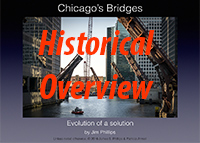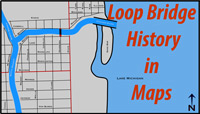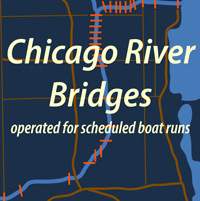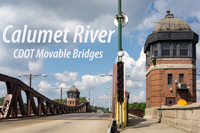W. Washington Blvd. bridge - opened May 26, 1913
On May 26th we sponsored a free day at the McCormick Bridgehouse & Chicago River Museum to observe the centennial of the Washington Blvd bridge and celebrate Chicago's movable bridges. We had 690 people attend the celebration. In addition, during the month of May we distributed about 1000 commemorative magnets (shown below). Thanks to all who helped us celebrate.
Let's not forget that the longevity of these beauties are the result of the stewardship of the CDOT crews that operate and maintain them. Next time you are at a raised bridge, let them know how much you appreciate their efforts.
Two more beauties are in the Loop "100 Club" now - Jackson Blvd and Lake St.
*****

The following is an excerpt from an email I received from Allen Hall from Glen Ellyn, IL:
Good People,
I cross the Washington St Bridge everyday for 17 yrs. I call it my "Daily Bridge" (a play on Daily Bread - ughhh). I saw a grouping of your magnets on the west end of the Washington bridge arranged in an open square and I thought it was clever stencil grafitti but when I got to the east end I touched one and realized it was a magnet. It is on my file cabinet, now. This is the best free thing I have gotten in a long time!
When walking the bridge, I love the moments when buses and trucks cross bouncing me about. It is a great feeling when looking at the river below. I was mourning when the wooden walkway was replaced with texurized steel plate, perhaps more structurally sound, but not as good of "bounce"!
Do you have something to say about this bridge? -- email it!
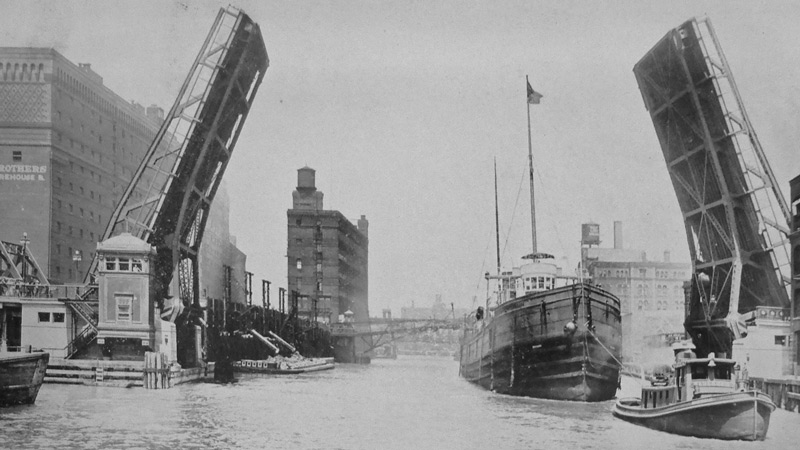
The new Washington Blvd. bridge in action.
(Image reproduced from the 1913 Annual Report of the Chicago Public Works Department)
The current bridge crossing the South Branch of the Chicago River at W. Washington Blvd. was opened one hundred years ago on May 26, 1913.
This bridge has been present for most of the 144 year history of the river crossing at Washington Blvd. During Chicago's first seventy years as a city, engineers experimented with many ways to satisfy the conflicting needs of land traffic and navigation interests at the river. One of these experiments was the tunnel at Washington Blvd., the first built in Chicago specifically for wagon and pedestrian traffic.
Opening in 1869, this tunnel (and a second built at LaSalle St. that opened in 1870) provided an escape path during the Great Fire in 1871 that the burning bridges couldn't. The steep approaches, damp, and dirty conditions made the tunnel unpopular with pedestrians. Eventually the tunnel was converted for use in the cable car, and later, the street car systems. In 1910, the tunnel was rebuilt and lowered 9 feet as the larger vessels ran aground on the top of it. The Washington Blvd. tunnel was closed in 1953, ending 84 years of service.
The first bridge was installed here in 1891, when the existing swing bridge at Madison St. was floated in. This swing bridge was in use until 1907 when it was demolished for both the lowering of the existing tunnel and the construction of the current bridge.
Today the Washington Blvd. bridge stands as a monument to the metamorphosis of the Chicago-type bascule bridges from first to second generation.
"This bridge was the first to include the ideals of the 1909 Plan of Chicago. Edward Bennett, co-author of the Plan, began collaborating with Chicago Public Works bridge engineers during the latter design stages of the bridge. That collaboration led to aesthetic considerations such as upgraded materials in the abutment walls, railings, lighting, and, most notably, in the bridgehouses.
Earlier bridgehouses resembled mid-west farmhouses. The Washington Blvd. bridgehouses incorporated more ornamentation and were clad in molded copper sheeting. While these houses are not as showy as those that followed, they were a step above what came before. These modest aesthetic features were added at a cost of about $14,000 or about 6% to the total cost of the bridge in 1913.
Technologically, this bridge involved innovations in two areas. First, due to the tunnel directly below the bridge, new foundation design techniques were developed and implemented here and used on bridges that followed. Second, features developed and patented in 1911 by Chicago Public Works engineer Alexander von Babo were incorporated into the design. The most significant of these design innovations was changing the location of the rack and pinion which made a striking difference in the appearance of the Chicago's bridges. The photo below contrasts the second generation bridge at Washington Blvd. with the first generation Kinzie St. bridge.

2nd and 1st Generation Chicago-type Bascule bridges. (Washington Blvd. - left / Kinzie St. - right)
Unlike the other downtown bridges, you won't find a plaque on the Washington Blvd. bridgehouses. The key players in the design and construction of this bridge were: John Ericson, City Engineer; Thomas G. Pihlfeldt, Chief Engineer; Alexander von Babo, Engineer of Bridge Design; Clarence S. Rowe, Construction Engineer; Edward H. Bennett, Chicago Plan Commission Architect; Strobel Steel Company built the superstructure; and Fitzsimons and Connell Dredge and Dock Company built the substructure. The substructure was completed in a year (August 25, 1911 – August 22, 1912). Work on the superstructure began June 25, 1912 and both leaves were lowered into position simultaneously on March 22, 1913; pavement and sidewalks were the last items completed.
Today, it's hard to imagine the number of vessels that used the Chicago River in the first part of the 20th Century. During 1914, the first full year of operation of this bridge, a total of 9,540 vessels entered and cleared the Chicago River. The Washington Blvd. bridge opened 3,773 times in that year alone.
The new Washington Blvd. bridge served as the finish line for the seventh annual Chicago river marathon in 1914. This event, a swim from the Chicago Harbor to various bridges from Wells St. to Van Buren St., was sponsored by the Illinois Athletic Club from 1908 to 1928. In 1908, the manager of the swim was quoted in the Chicago Daily Tribune, “If the swimmers can stand the odor which is said to come from the water they will be able to finish without much great effort.” About 55 swimmers competed in the 1914 race.
Today, in semi-retirement, the bridge is raised only about 40 times a year, mostly during the Spring and Fall sailboat runs to and from Lake Michigan. About 14,000 vehicles and 9,500 pedestrians cross this bridge daily. Based on the available data, it is estimated that this bridge has been raised about 70,000 times in it's 100 years.
The houses may need some TLC, but the recent paint job on the trusses and new sidewalks make this bridge a good looking centenarian.
Sources used include: Chicago Public Works Annual Reports 1910-1925; Chicago Daily Tribune archive via ProQuest; Two Miles Eighteen Bridges – A walk along the Chicago River; & chicagoloopbridges.com

